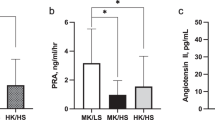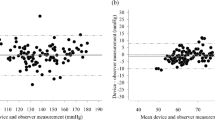Abstract
The assessment of sodium sensitivity requires to measure the difference in mean arterial pressure (MAP) at the end of sodium-loading (SLoad) and sodium-depletion (SDepl) maneuvers with an arm-cuff manometer. Aim of this study is to evaluate whether MAP measuring devices based on the volume-clamp method at the finger can also be used for assessing sodium sensitivity. Sixty-eight normotensive volunteers underwent SLoad and SDepl diets in random order. MAP was simultaneously measured at the end of each diet with arm (Spacelabs 90207) and finger (Portapres model-2) cuff devices. The sodium sensitivity was assessed as the difference in MAP at the end of SLoad and SDepl diets (ΔMAP), and as salt-sensitivity index (SSI; SSI=ΔMAP divided by the difference in urinary-sodium-excretion rate at the end of the diets). Discrepancies between finger and arm-cuff devices in ΔMAP or SSI were evaluated by Bland and Altman analysis. Even if discrepancies between devices had null-fixed bias, results showed a significant proportional bias and large limits of agreement (between −25 and 25 mm Hg for ΔMAP, between −196 and 180 mm Hg mol−1 per day for SSI). The SSI distribution over the group was larger, flatter and less symmetric if derived from finger-cuff rather than arm-cuff devices, and this influenced substantially the identification of salt-sensitive individuals. Therefore, the response of MAP to SLoad/SDepl diets and consequently the assessment of the salt-sensitivity condition depends importantly on the measurement site, and brachial measures should be preferred for consistency with literature and normative data.
This is a preview of subscription content, access via your institution
Access options
Subscribe to this journal
Receive 12 digital issues and online access to articles
$119.00 per year
only $9.92 per issue
Buy this article
- Purchase on Springer Link
- Instant access to full article PDF
Prices may be subject to local taxes which are calculated during checkout




Similar content being viewed by others
References
Castiglioni P, Parati G, Brambilla L, Brambilla V, Gualerzi M, Di Rienzo M et al. A new index of sodium sensitivity risk from arterial blood pressure monitoring during habitual salt intake. Int J Cardiol 2013; 168 (4): 4523–4525.
Castiglioni P, Parati G, Brambilla L, Brambilla V, Gualerzi M, Di Rienzo M et al. Detecting sodium-sensitivity in hypertensive patients: information from 24-hour ambulatory blood pressure monitoring. Hypertension 2011; 57 (2): 180–185.
Weinberger MH . Salt sensitivity of blood pressure in humans. Hypertension 1996; 27 (3 Pt 2): 481–490.
Kimura G, Brenner BM . Implications of the linear pressure-natriuresis relationship and importance of sodium sensitivity in hypertension. J Hypertens 1997; 15 (10): 1055–1061.
Coruzzi P, Parati G, Brambilla L, Brambilla V, Gualerzi M, Novarini A et al. Effects of salt sensitivity on neural cardiovascular regulation in essential hypertension. Hypertension 2005; 46 (6): 1321–1326.
Imholz BP, Langewouters GJ, van Montfrans GA, Parati G, van Goudoever J, Wesseling KH et al. Feasibility of ambulatory, continuous 24-hour finger arterial pressure recording. Hypertension 1993; 21 (1): 65–73.
Omboni S, Parati G, Frattola A, Mutti E, Di Rienzo M, Castiglioni P et al. Spectral and sequence analysis of finger blood pressure variability. Comparison with analysis of intra-arterial recordings. Hypertension 1993; 22 (1): 26–33.
Castiglioni P, Parati G, Omboni S, Mancia G, Imholz BP, Wesseling KH et al. Broad-band spectral analysis of 24 h continuous finger blood pressure: comparison with intra-arterial recordings. Clin Sci (Lond) 1999; 97 (2): 129–139.
Gizdulich P, Prentza A, Wesseling KH . Models of brachial to finger pulse wave distortion and pressure decrement. Cardiovasc Res 1997; 33 (3): 698–705.
O'Brien E, Parati G, Stergiou G, Asmar R, Beilin L, Bilo G et al. European Society of Hypertension position paper on ambulatory blood pressure monitoring. J Hypertens 2013; 31 (9): 1731–1768.
Finapres Medical Systems BV. Beatscope 1.1 User's Guide. FMS Publishers: Arnhem, The Netherlands 2002.
Hojgaard MV, Holstein-Rathlou NH, Agner E, Kanters JK . Reproducibility of heart rate variability, blood pressure variability and baroreceptor sensitivity during rest and head-up tilt. Blood Press Monit 2005; 10 (1): 19–24.
Protogerou AD, Argyris A, Nasothimiou E, Vrachatis D, Papaioannou TG, Tzamouranis D et al. Feasibility and reproducibility of noninvasive 24-h ambulatory aortic blood pressure monitoring with a brachial cuff-based oscillometric device. Am J Hypertens 2012; 25 (8): 876–882.
Hohn A, Defosse JM, Becker S, Steffen C, Wappler F, Sakka SG . Non-invasive continuous arterial pressure monitoring with Nexfin does not sufficiently replace invasive measurements in critically ill patients. Br J Anaesth 2013; 111 (2): 178–184.
Elvan-Taspinar A, Uiterkamp LA, Sikkema JM, Bots ML, Koomans HA, Bruinse HW et al. Validation and use of the Finometer for blood pressure measurement in normal, hypertensive and pre-eclamptic pregnancy. J Hypertens 2003; 21 (11): 2053–2060.
Nichols W, O'Rourke M, Vlachopoulos C (eds). McDonald's Blood Flow in Arteries, 6th edn. Theoretical, Experimental and Clinical Principles. CRC Press: Boca Raton, FL, USA, 2011, pp 768.
Author information
Authors and Affiliations
Corresponding author
Ethics declarations
Competing interests
The authors declare no conflict of interest.
Rights and permissions
About this article
Cite this article
Castiglioni, P., Parati, G., Di Rienzo, M. et al. Blood pressure changes after high- and low-salt diets: are intermittent arm measures and beat-by-beat finger measures equivalent?. J Hum Hypertens 29, 430–435 (2015). https://doi.org/10.1038/jhh.2014.110
Received:
Revised:
Accepted:
Published:
Issue Date:
DOI: https://doi.org/10.1038/jhh.2014.110



